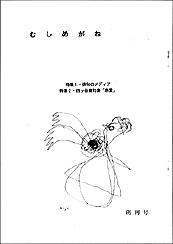
- Haiku, Tanka, Literature, And Contemporary Art in
Japan -
From Tokyo, Japan
Contents
What Is "Mushimegane"
?
- The word "Mushimegane" means "loupe"
in Japanese.
"Mushimegane" is a literary magazine published by Ryu Yotsuya & Niji
Fuyuno.
- We issue 1 or 2 numbers a year.
- "Mushimegane" mainly prints haiku works of Ryu
& Niji, and also carries criticisms of haiku, tanka, literature,
art, movies, and music.
Adding to the printed "Mushimegane", we have opened
this "Mushimegane on the Internet". We deliver our
pieces and criticisms of haiku, tanka, literature, contemporary
art, etc.

"Mushimegane" vol.1 (1987)
The Chronicle of
"Mushimegane"
- Literary magazine "Mushimegane" was first published in September
1987 in Kobe, Japan. From the No.5, we issued it in Tokyo.
Subjects of every number are full of originality, and delicate
illustrations by Niji Fuyuno have won popularity.
We introduce you the subjects of Mushimegane's past numbers .
No. 1 (1987) "The media of haiku"
- Inviting Mr. Toshinori Tsubouchi, haiku poet, we discussed
how will change the means to make public our haiku pieces. At
that time, we didn't imagine at all that there would appear new
media, named "internet".
No. 2~3 (1988~89) "Revaluate Ippekiro Nakatsuka"
- Do you know Ippekiro Nakatsuka, haiku poet in Taisho era
(1912~1926) ? His haiku works are very creative and filled with
genius, so it isn't easy to believe there lived such a modern
haiku poet over 80 years ago.
- In this number we introduced his unpublished haiku pieces
and essays. These articles got great reputation in the haiku
world.
No. 6 (1991) "Tracing the works of Seito Hirahata"
- Seito Hirahata is a great haiku poet, but the real value
of his works has not be recognized well in the haiku circles.
We lightened his career form his student time to the present.
No. 10 (1994) "Between the war and
haiku"
- During the World War II, many famous haiku poets approved the war and made
pieces glorifying the Japan army. We collected haikus concerning to the war
and studied how the thoughts and the aesthetics of the haiku poets have related
to the war.
No. 11 (1994) "Natsuyuki Nakahishi
- 'G/Z HOHO Group'"
- Natsuyuki Nakanishi is one of the artists representing the
contemporary art scene.
We commented on the colors and the way of comprehension of space
and time in his works, specially the paintings in the exhibition
titled "G/Z HOHO Group"(1994).
No. 14 (1998) "Invitation to the history of world-wide haiku"
- To commemorate the publication of "Haïku sans frontières: une anthologie mondiale",
the first world-wide haiku anthology in history edited by André Duhaime in Canada, we inspected the process
of Western haiku development. In this issue, we translated and placed such
articles as:
- "Turning with the Earth" (R. Yotsuya), "Historical Notes
on Haiku in French" (B. Guillemette), "Historical Notes on Haiku
in English" (E. S. Lamb), "Haiku in English" (G. Swede), "Trackless Tracks: the Development of Haiku in Britain"
(M. Lucas), "Haiku in Belgium" (B. Mesotten), "Haiku in Romania" (C. Ifrim).
-
The Latest
No. 15 (2000) "World-wide haiku read
by world-wide poets"
- The latest number published in September 2000. We organized a international
critique project, where 9 poets of 4 countries appreciate haikus written in
other countries than theirs. You will find the critical level of these articles
are very high. If you want to read them, click
here.
We have published memorial articles for Haruko Iijima, too. Niji and Ryu respect
her from the bottom of their hearts.
Go back to the TOP.
History of haiku
/ Haiku / Tanka
/ Romance / Profile
Japanese / French
e-mail to Ryu Yotsuya & Niji Fuyuno
loupe@big.or.jp


French
Japanese
